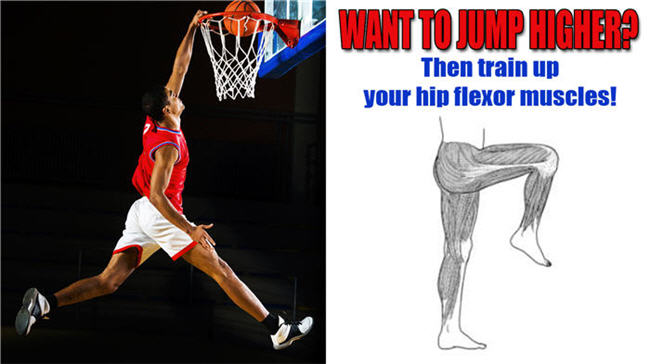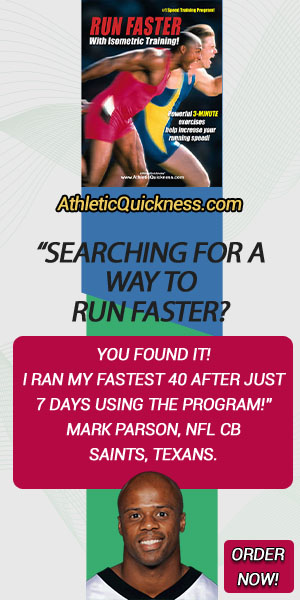How to add a few more inches to your running vertical jump in less than two weeks
Train your hip flexors for just 3 minutes a day
and watch your leaping ability soar!
Hey, basketball players, does your vertical jump coach have you training your “Pectineus” muscles? or “Sartorius” muscles? SAY WHAT? Why do I need to train these muscles? I didn’t know they even existed!
Read carefully. If you want to increase vertical jump height as much as possible and increase running speed as much as you can, then you need to read this article.
Two Most Important Muscles When Running and Jumping
These two muscles are parts of a group of muscles known as your hip and thigh flexor muscles. And, your hip flexors muscles are the most important muscle group in your body affecting jumping higher and running faster.
Ok, so maybe you’ve heard of the hip flexor muscles; but, you say, I do all the necessary training to increase my vertical leap, such as bounding exercises, squats, leg presses, knee extensions, jumping off platforms, etc.
All of these types of exercises are good as each of them target one or more of the muscle groups involved in the running vertical jump. But here’s the catch: combined, they don’t target ALL the muscles involved in the running vertical jump.
Years ago, when I accidentally discovered the secret to running faster and jumping higher, I was amazed at how one of the most important muscle groups in my body was ignored and never received a single day of relevant training.
Probably like you, I spent hours in the gym, on the court or at the track. Each time I finished my workouts, I was exhausted thinking I did all I could to get better. I achieved some personal milestones in my training and for the most part was pleased. However, I never actually had a major breakthrough that I could credit to any one particular type of training strategy or exercise for any of my success.
That all changed several ago. To make a long story short, I used the resistance band with an isometric training strategy on my hip flexors and, unknowingly at the time, unlocked a huge reservoir of untapped muscular potential.
Talk about flipping on a switch and instantly seeing a difference! I was able to run significantly faster and jump higher within a day or two. No kidding.
Longest and Most Powerful Muscles are Under Trained!
When I looked back to see what I did that was so special, I realized that the longest and most powerful muscles in my body, the hip flexors, had never had the slightest amount of additional resistance training.
Sure, I’ve seen the rotary hip machines in the gym but personally, I never took that machine seriously. The reason why I don’t use that machine too much, if at all, is because the muscles it exercises always remain hidden, deep within the body and certainly covered up by clothing. “If you can’t see them, why train them?” was my attitude. That’s no reason not to use the machine, but it’s also not the way I now recommend to ‘flip the switch’ on your hip flexors.
[sc name=”2step-optin”]
Why hip flexor muscles are important to increase vertical jump
Have you ever watched a high jumper jump? Ever seen a pretty average looking guy clear 7+ feet? Pretty amazing, isn’t it? What’s their secret? First, clearing 7+ feet in the high jump doesn’t just happen overnight, and I can only imagine the amount of hours and dedication it must take just to get near this height.
But with every major goal that gets accomplished, more often than not it is the product of a whole bunch of little ones stacked on top of each other. One of the “little” things you can do right now to make yourself a better vertical jumper is take a closer look at the technique involved with high jumping.
Initially it all appears to be in slow motion as you see the jumper approaching the bar and then in the last few steps, there are two things to watch for, and none of them have to do with the foot on the ground that pushes off.
These two little things are: 1) both of the high jumper’s forearms are quickly thrust upward and 2) the thigh of the leg that leaves the ground first is also thrust upward as hard and fast as it can.
What is the effect of these two movements? The effect of thrusting both of your forearms and one thigh upward, at the same time the other leg is pushing off the ground, is to create more momentum in the direction you are traveling.
More specifically the effect of these upward thrusts is to make your body momentarily lighter so the foot pushing off the ground has less weight to overcome. With your body weight being momentarily lowered, you are able to execute a relatively stronger and higher jump.
You can test this theory right now!
One of the neat things you can do right now to see the effects that thrusting your arms upward has on your body weight is start by standing on any scale. It doesn’t matter what kind of scale you use whether it’s a home digital scale or a more professional type one with balance weights.
Stand on the scale and let your weight settle. It may take just a few seconds. Once you’ve done that, simply reach and stretch both of your arms overhead relatively quickly although not so fast that you lose your balance. You will also need to be looking at the scale to watch what happens to your weight. You will notice that the weight drops a few pounds for a second or two, then it returns back to your normal weight.
A second or two of lowered body weight is a major ingredient to increase your vertical jump. Now imagine how much more weight your body weight gets lowered when you not only aggressively thrust both forearms in the air, but also by thrusting one of your much larger and stronger thighs? If done right, it can have the effect of momentarily dropping your body weight 30+ pounds!
This is why training your hip flexors is so important to improving your running vertical leap. If you simply think that all of your jumping skills involve only the last foot to leave the ground, you’re mistaken.
What’s the best way to train the hip flexors?
The most efficient way to train your hip flexors is by using the resistance band with an isometric training strategy. There are several unique positions to put the thigh in while exercising this way to create significantly improved upward thrust. They are all explained in our JUMP HIGHER with Isometric Training program.
Training this way requires from 3 to 9 minutes a day and, the results are typically seen in just a few days. Certainly you have time to add this into your workout. Until you include a hip flexor workout, the way our programs teach, in your current jump training program, you will always be operating at less than 100% efficiency. And just like trying to excel at any athletic skill, every little thing you do to help yourself improve stacks up until your goals not only come within reach, but are ultimately surpassed.
Including an isometric training program using resistance bands into your current vertical jump training routine is simpler and more powerful than you think. All of this valuable information has already been researched, tested and is currently available for you from AthleticQuickness.com.
So, if you want to be faster, quicker and start jumping higher in just a matter of days, you need to be including into your workouts the training programs that get more results in less time than any other type of training programs.
This will be the one time where you will be able to identify and credit the training that made the difference … just hope your competition doesn’t get there first.
Always glad to help,
Dr. Larry Van Such
[sc name=”2-stepoptin-blue”]
[sc name=”jumphigher testimonial banner – green”]
[sc name=”Order Here Button-01″]






